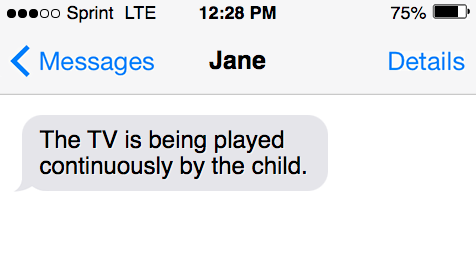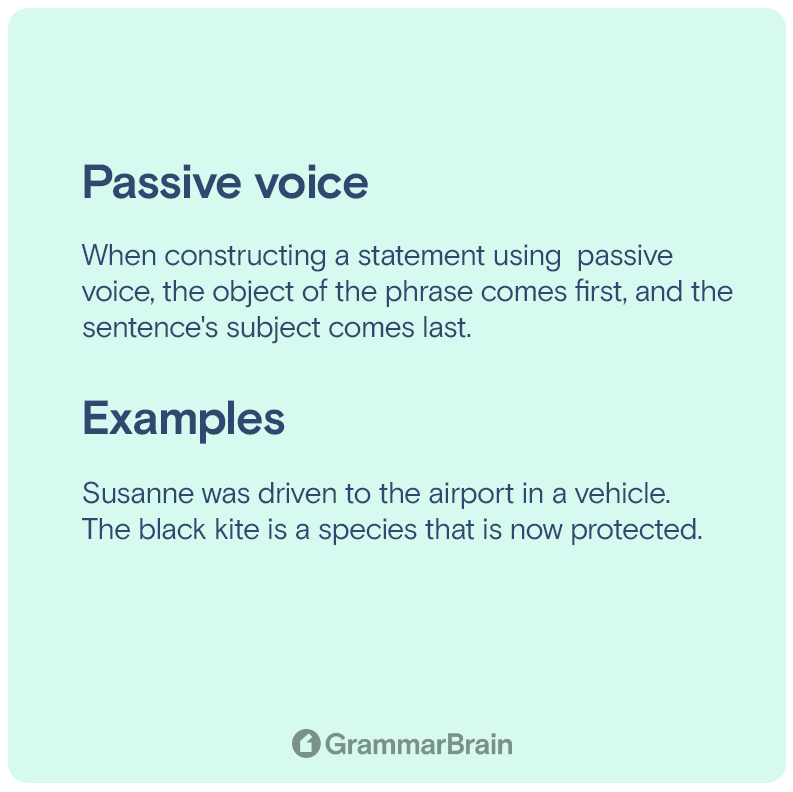What is passive voice? And what is active voice? Does the use of passive verbs make passive voice? Does it have an effect on the writing tone?
Learn everything about passive voice (and the differences with active voice) in this worksheet…
What is passive voice?
When constructing a statement using passive voice, the object of the phrase comes first, and the sentence’s subject comes last.
Although passive voice is not a grammatical error, it makes your writing less straightforward and understandable.
When we wish to put more emphasis on the action (the verb) and the object of a statement rather than the subject of the phrase, we employ passive voice.
This indicates that the topic is either not as significant as the action itself or that we do not know who or what the subject is. Either of these possibilities is possible.

What are examples of passive voice?
1. Susanne was driven to the airport in a vehicle.
In this instance, Susanne did not carry out the action corresponding to the verb “to drive.” She was the recipient of the action. She was the one who benefited from the activity.
2. The black kite is a species that is now protected.
The process is being carried out in relation to the topic of “black kite.”
3. In this chamber, the grapes are crushed, and the juice is extracted from them.
The action, which is being carried out, is being done to “the grapes.”

How to recognize passive voice
To determine if a sentence has an active or passive voice, consider both what occurred and who was accountable for carrying it out.
If the person or object responsible for doing the acts is either removed from the phrase entirely or comes in the sentence after the event. If you find a past participle directly after the form of “to be,” the statement is written in passive voice.
Examples:
1. Invasion was carried out in Afghanistan.
Passive voice is used when the agent of the action is not present.
2. The Soviet Union invaded Afghanistan.
That is known as passive voice. The action is described in the second sentence, followed by the person who carried it out.
3. The Soviet Union invaded Afghanistan.
This is an example of active voice. The one who takes action comes first.

How to use passive voice
When there is uncertainty regarding who was responsible for anything that had a place, the passive voice is often chosen:
- An unidentified person stole the car.
- The factory was set ablaze early in the wee hours of the morning.
- The terrifying tales were passed around the school camp.
As seen from the first two instances, passive voice is appropriate when discussing unsolved cases.
| Tense | Active voice | Passive voice |
| Present simple | The teacher punishes me. | I am punished by the teacher. |
| Present continuous | The teacher is punishing me. | I am being punished by the teacher. |
| Past simple | The teacher punished me. | I was punished by the teacher. |
| Past continuous | The teacher was punishing me. | I was being punished by the teacher. |
| Present perfect | The teacher has punished me. | I have been punished by the teacher. |
It is also acceptable to use passive voice when the person who is doing the activity is unimportant:
- Example: The Museum was shown to the public for the first time in 1942.
In this particular instance, we are not concerned with the identity of the person who unveiled the monument.
Instead, we are interested in the date the statue was revealed to the public. That justifies the use of passive voice.

When to avoid using passive voice
When writing in a more professional or academic style, the use of the passive voice is often discouraged.
Using passive voice in more casual and informal communication is more acceptable.
To prevent confusing statements
Using passive voice might result in lengthy phrases that are difficult to understand.
It can also lead to sentences that just sound weird.
To avoid unclear statements
If using passive voice makes a statement too ambiguous, avoid using it.
To stay away from unknown sources
Because it enables a speaker to make assertions or comments without expressly specifying a source of information; passive voice is often frowned upon in the academic world.
How to form passive voice
You can create sentences in the passive voice by following this structure::
- Subject in the passive voice + to be + past participle
It is important to note that the participle form of the primary verb comes after conjugating the word “be.”
For instance:
- The farm was established in 1972.
- My colleague is being interviewed today.
- The construction of the dam has been finished recently.
In most cases, passive voice does not use the perfect continuous or other perfect tenses.
Present simple
The structure of passive voice in the present simple is: am / is / are + past participle (3rd form of the verb).
Example
- A senior student assisted the newcomer to the class.
Present progressive
When forming passive voice in the present progressive tense, use this structure:
- The present tense form of the verb to be (am, is, are) +being + the past participle form of the verb (eaten, done, began, etc.).
Example
- The TV is being played continuously by the child.
Past simple
Passive voice in the past simple tense is created like this:
- Object + was/were + Past Participle form of the verb + subject
Example
- The Kite Runner was written by Kahlil Gibran.
Past progressive
Passive voice in the past progressive tense is created like this:
- Object + was/were + being + past participle + by + subject
Example
- Harry Potter was being defeated by Draco Malfoy in a duel.
Future tense
Passive voice in the future tense is created like this:
- Object + will/shall + be + past participle form of verb
Example
- The project will be finished by Susanne tomorrow.
Present perfect
Passive voice in the present perfect tense is created like this:
- Object + has/have + been + past participle form of the verb + by + subject
Example
- James has been confronted by the principle.
Future perfect
Passive voice in the future perfect tense is created like this:
- Object + will/shall + have been + past participle form of verb + Subject
Example
- Timothy will have been going to Germany.
Modals (can/could)
Here is how you can make passive voice using modals (can/could):
- Object + can/could + be + past participle form of verb + by + Subject
Example
- The book could have been torn by Susanne.
Modal (must)
Here is how you can make passive voice using modals (must):
- Object + must + be + past participle form of verb + by + Subject
Example
- The book must be returned by John to the librarian.
What is stative and dynamic passive voice?
Most of the time, dynamic verbs, also known as “action verbs,” are used to describe either acts that we can take or events that take place.
Stative verbs often relate to a situation or circumstance that is stable or unlikely to undergo any changes in the near future.
This distinction is significant because stative verbs typically cannot get employed in the continuous forms (BE + ING) derived from BE.
Examples of misuse of passive voice
1. Sam was going to the departmental store. The sun was at its prime, and it made him sweat. His sister had told him to buy noodles because her friend had told her to bring noodles to the sleepover.
In this example, Sam is reactive. His sisters tell him to bring noodles. Her friend wants her to make noodles for the sleepover. The sun was sweltering and it made him sweat.
Here are some simple examples of misuse:
- Samantha planned the trick.
- The wedding cake was bought by Simone.
- The school team was given multiple awards by the coaches.
- A fun party was enjoyed by all.

How to fix passive voice in writing
Most of the time, changing a sentence written in the passive voice into one written in the active voice is the most effective way to improve the overall writing quality.
The active and passive forms of the phrase need to convey the meaning to the reader.
In most cases, the subject of a statement written in passive voice is recast as the sentence’s direct object. The person doing the action is the subject of the new sentence in the [now] active voice.
Let’s look at some problematic statements and correct them to see how this works.
In the passive: The show was watched by my brother.
In the active: My brother watched the show.
“The show” was shown as the subject in the passive sentence. When changed to an active sentence, it now becomes the direct object.
Additional examples are as follows:
1. Passive: The tourist accidentally fell into a hole that was inhabited by both non-poisonous spiders and dangerous tarantulas. He sustained many bite wounds.
Active: The traveler was unfortunate enough to fall into a hole that both harmless spiders and dangerous tarantulas inhabited. To his good fortune, only the spiders repeatedly bit him.
2. Passive: It has been established that dogs make better companion animals than cats.
Active: The Society for the Preservation of Dogs and Cats concluded that cats make poorer pets than dogs.
FAQs
What is passive voice construction?
The most common construction is a variant of the auxiliary verb ‘to be’ followed by the past participle of a transitive verb.
What’s the difference between active and passive voice?
Here’s the formula for active voice: [subject]+[verb (performed by the subject)]+[optional object]
Passive voice usually refers to the object in a passive manner.
How do I turn a passive voice sentence into an active one?
You can change words like “be” to “get.” Or “may” to “can.” Active sentences sound more definitive. It’s best to avoid passive sentences in formal writing (scientific writing, essays, etc.). Use the passive voice for informal writing, like letters or emails.
Sentence structure
More on sentence structure:
Inside this article
Fact checked:
Content is rigorously reviewed by a team of qualified and experienced fact checkers. Fact checkers review articles for factual accuracy, relevance, and timeliness. Learn more.
Core lessons
Glossary
- Abstract Noun
- Accusative Case
- Anecdote
- Antonym
- Active Sentence
- Adverb
- Adjective
- Allegory
- Alliteration
- Adjective Clause
- Adjective Phrase
- Ampersand
- Anastrophe
- Adverbial Clause
- Appositive Phrase
- Clause
- Compound Adjective
- Complex Sentence
- Compound Words
- Compound Predicate
- Common Noun
- Comparative Adjective
- Comparative and Superlative
- Compound Noun
- Compound Subject
- Compound Sentence
- Copular Verb
- Collective Noun
- Colloquialism
- Conciseness
- Consonance
- Conditional
- Concrete Noun
- Conjunction
- Conjugation
- Conditional Sentence
- Comma Splice
- Correlative Conjunction
- Coordinating Conjunction
- Coordinate Adjective
- Cumulative Adjective
- Dative Case
- Determiner
- Declarative Sentence
- Declarative Statement
- Direct Object Pronoun
- Direct Object
- Diction
- Diphthong
- Dangling Modifier
- Demonstrative Pronoun
- Demonstrative Adjective
- Direct Characterization
- Definite Article
- Doublespeak
- False Dilemma Fallacy
- Future Perfect Progressive
- Future Simple
- Future Perfect Continuous
- Future Perfect
- First Conditional
- Irregular Adjective
- Irregular Verb
- Imperative Sentence
- Indefinite Article
- Intransitive Verb
- Introductory Phrase
- Indefinite Pronoun
- Indirect Characterization
- Interrogative Sentence
- Intensive Pronoun
- Inanimate Object
- Indefinite Tense
- Infinitive Phrase
- Interjection
- Intensifier
- Infinitive
- Indicative Mood
- Participle
- Parallelism
- Prepositional Phrase
- Past Simple Tense
- Past Continuous Tense
- Past Perfect Tense
- Past Progressive Tense
- Present Simple Tense
- Present Perfect Tense
- Personal Pronoun
- Personification
- Persuasive Writing
- Parallel Structure
- Phrasal Verb
- Predicate Adjective
- Predicate Nominative
- Phonetic Language
- Plural Noun
- Punctuation
- Punctuation Marks
- Preposition
- Preposition of Place
- Parts of Speech
- Possessive Adjective
- Possessive Determiner
- Possessive Case
- Possessive Noun
- Proper Adjective
- Proper Noun
- Present Participle
- Prefix
- Predicate



